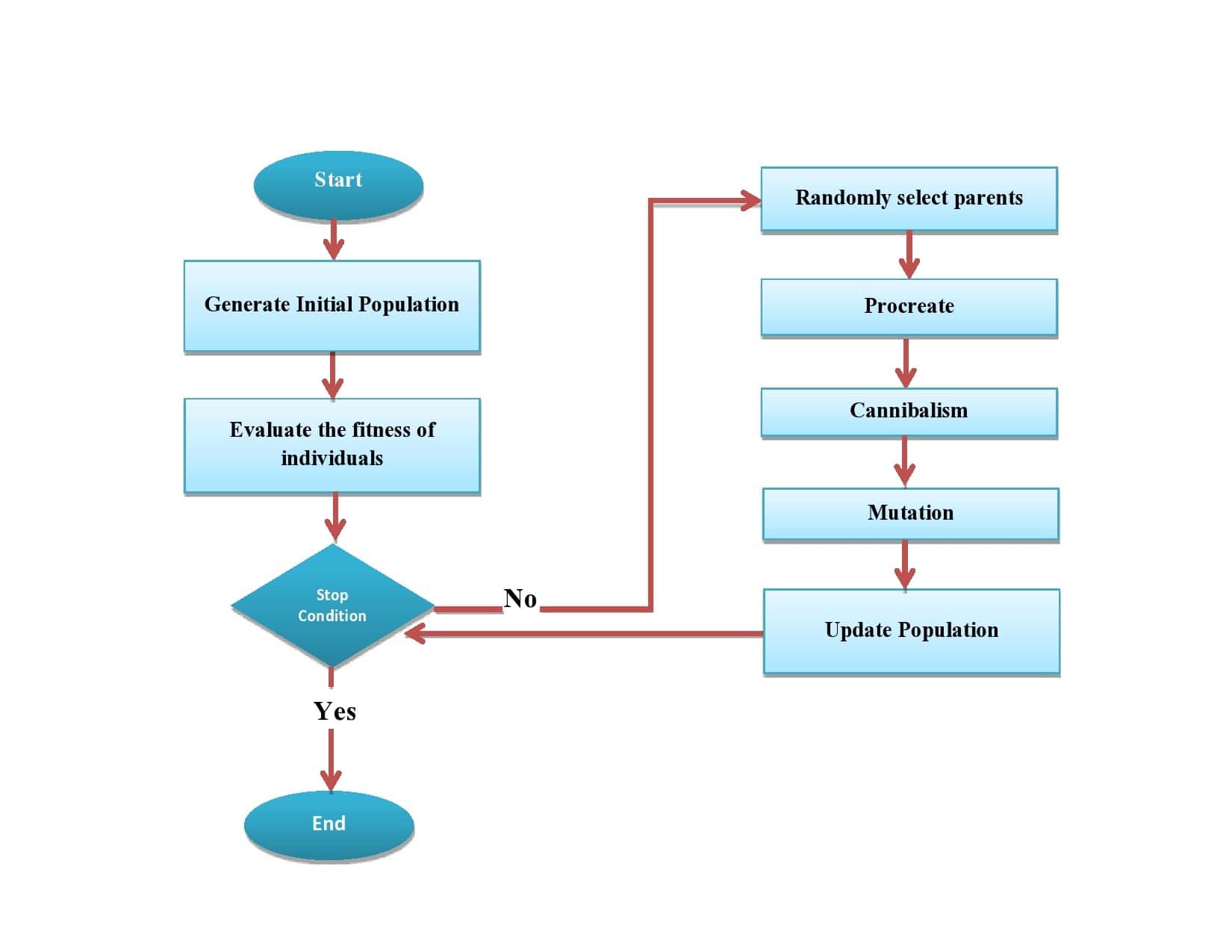1. 引言
在工程与科研领域,我们经常面临复杂的优化问题。由于其简单性和通用性,元启发式算法(Metaheuristic Algorithms) 成为了处理这些问题的重要工具。尤其是在面对 NP 难题时,它们能以相对高效的方式找到近似最优解或全局最优解。
本文将介绍一种近年来提出的新型元启发式算法 —— 黑寡妇优化算法(Black Widow Optimization, BWO),其灵感来源于黑寡妇蜘蛛的交配行为。
2. 自然启发
BWO 的灵感源自黑寡妇蜘蛛的三种行为特征:
- 交配后雌性吃掉雄性(交配与淘汰机制)
- 攻击性强(用于捕获猎物)
- 织网策略(构建结构以提高捕猎效率)
在算法中,这些行为被抽象为以下操作:
- 淘汰低质量解(模拟“吃掉弱者”)
- 通过交叉生成新解(模拟“交配”)
- 利用变异增强搜索(模拟“织网”)
这些机制共同引导算法向最优解逼近。
3. 黑寡妇优化算法(BWO)
3.1 算法概述
BWO 的核心流程如下图所示:

算法流程简述如下:
- 初始化种群:随机生成若干“黑寡妇”个体(解)
- 评估适应度:计算每个个体的适应度值
- 交配与淘汰:选择适应度高的个体进行交配,淘汰适应度低的个体
- 变异操作:对部分子代进行变异
- 更新种群:将新生成的子代与变异个体加入种群
- 重复以上步骤,直到满足停止条件
最终目标是找到一个全局最优解,即在所有解中适应度最高的那个。
4. 伪代码实现
以下是 BWO 的伪代码:
algorithm BlackWidowOptimization(N, D, ReproductionRate, CannibalismRate, MutationRate, f):
// INPUT
// N = 种群大小
// D = 问题维度
// ReproductionRate = 交配率
// CannibalismRate = 淘汰率
// MutationRate = 变异率
// f = 适应度函数
// OUTPUT
// 最优解
Initialize widows, 随机初始化黑寡妇种群
Evaluate each widow using f
best <- find the best widow
N_R <- N * ReproductionRate // 交配个体数
while stop condition not met:
parents <- 从 widows 中选取 N_R 个最优个体
children <- 空数组
best <- 当前最优个体
for i <- 1 to N_R:
从 parents 中随机选两个个体
生成 D 个子代
从 parents 中移除父亲个体
保留 CannibalismRate * D 个最优子代加入 children
mutated <- 空集合
for i <- 1 to N * MutationRate:
从 children 中随机选一个个体
对其进行变异
加入 mutated 集合
widows <- 将 children 与 mutated 合并作为新种群
return best
4.1 交配阶段
在交配阶段,我们从当前种群中选择两个个体作为父母,生成 D 个子代。生成方式如下:
设 w1 和 w2 是两个 D 维向量,α 是一个 D 维的随机数数组(范围 [0,1]),则子代 y1 和 y2 如下:
$$ \begin{aligned} y_1 &= \alpha \times w_1 + (1 - \alpha) \times w_2 \ y_2 &= \alpha \times w_2 + (1 - \alpha) \times w_1 \end{aligned} $$
这样可以保证子代继承父母特征的同时引入多样性。
4.2 淘汰机制
BWO 中的“淘汰”体现在两个方面:
- 父代淘汰:每对交配后,淘汰适应度较差的个体(即“父亲”)
- 子代淘汰:保留 CannibalismRate * D 个最优子代,其余舍弃(模拟“兄弟相食”)
✅ 优点:防止种群爆炸,保持搜索方向明确
❌ 缺点:淘汰率设置不当可能导致早熟收敛
4.3 变异阶段
在变异阶段,我们从子代中随机选择部分个体,交换其两个维度的值,以增加种群多样性。
例如:
mutate(child) {
int i = randomIndex();
int j = randomIndex();
swap(child[i], child[j]);
}
⚠️ 注意:变异率不宜过高,否则会破坏优秀个体的结构
4.4 停止条件与种群控制
算法的停止条件通常是达到最大迭代次数。为保持种群大小稳定,需满足以下公式:
$$ D \times CannibalismRate \times (1 + MutationRate) = \frac{1}{2} $$
这确保了每次迭代中新增个体数等于被淘汰个体数,从而维持种群总数 N 不变。
5. 总结
黑寡妇优化算法(BWO)是一种受自然界黑寡妇蜘蛛行为启发的新型元启发式算法。它通过模拟交配、淘汰和变异等行为,在复杂优化问题中表现出色。
✅ 优势:
- 搜索能力强
- 收敛速度快
- 适应性广
❌ 挑战:
- 参数设置敏感(如 CannibalismRate、MutationRate)
- 需要良好的适应度函数设计
BWO 已在多个优化问题中取得良好效果,是值得深入研究与应用的一种智能优化算法。